Hide
Rounday, St. John's church.
hide
Hide
Hide
ROUNDHAY:
Source=h:/!Genuki/RecordTranscriptions/WRY/RoundhayStJohnCarolineFeeman.txt St. John's Church, Roundhay
by Caroline Feeman.
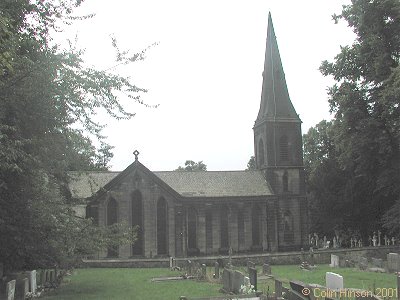 |
| St. John's Church, Roundhay in 2001 |
I grew up in Oakwood, Leeds and although I have lived in Ohio, USA, for nearly 40 years, I visit Leeds regularly, at least once a year, and have remained in contact with the community.
One hundred and forty years ago, on 19th September 1872, Prince Arthur officially opened Roundhay Park (now a Grade 2* Park and the 2nd largest municipal park in Europe) which had been purchased by the City of Leeds from the estate of William Nicholson. The estate was over 700 acres and included a 30 acre lake, a 5 acre lake, a mansion house with associated buildings, a 'folly', a school, almshouses and St. John's church with a vicarage. The sale did not include the church which became the property of the Church of England. Sadly, the church building and land became too much of a financial burden on the congregation and the last service was held in 2007. It is because my family has experienced the circle of life in St. John's that its present deplorable state has become the subject of my concern over the years.
The church was constructed in 1826, was extended and modernized in the 1880s and the plain glass windows were replaced with splendid stained glass windows. The building, about three miles from the city centre, sits on a slope in a peaceful rural area away from the road and divides two graveyards. The south and older yard was cordoned off in 2003 due to the insurance company's insistence following a law suit in which a young boy was killed by a falling monument in Harrogate. Since then it has been observed that the soil is subsiding down the slope. The north yard, which is still being used, is where my family is buried. In 2008, when we held the internment service for my mother, I was shocked at the state of the south yard: it resembled the forest surrounding Sleeping Beauty's castle more than a final resting place for those who founded, worshipped at and supported the church. Thus began my search for answers to the fate of the property.
I started at the Diocese and learnt that the Pentecostal City Mission Church Limited, based in London and under the direction of Bishop Herbert Cato,was interested in acquiring the property. The gentleman I spoke to implied that the monuments in the south yard may have to be binned! The Pentecostal City Mission purchased the church in 2010 for 1GBP but has never held regular services there, in fact it has been completely abandoned since early 2011. The purchase was subject to a few covenants including: 1. The City Mission 'repair' the south graveyard and that this would have to be done by 2015. 2. That the north yard be maintained as it was still being used for burials and the City Mission not restrict access to the graveyard for those people wishing to tend to graves.
It was in early 2011 that blue tarp was placed on the porch roof due to lead theft and the subsequent water leaks and so I made further enquiries to the Diocese. The very obliging successor to the previous gentleman I met in 2008 made several futile attempts to ensure the City Mission secured the church, a grade 2 listed building, against the elements before contacting the Listed Buildings Department of the Council who have also encountered a 'wall of silence'. Only in December 2012 when the Council sent Bishop Cato an Urgent Works Notice did he agree to pay a contractor to do the appropriate repairs according to the standards set out by the Leeds Council. These included the roof repairs, fabric gutter linings and the replacement of coping stones. Despite snow and bad weather the work started in January 2013 and should be completed by the end of February. To add insult to injury, the north yard has not been mowed at all in well over a year and probably not since the City Mission took over. Trees from the properties surrounding the church are encroaching onto the graveyard, and weeds, ivy, nettles and grass are obscuring many graves. Bearing in mind the past behaviour of the City Mission, I am afraid that if this is allowed to continue it will fall to the same fate as the south yard. In August 2012 the church was broken into but it was the council that placed a metal plate over the door. People who have had access to the church, such as Diocese and Council representatives, have noted that mold is very much in evidence and the rotting wood finally caused the organ (restored in 2005) to fall off the wall in the early winter of 2013.
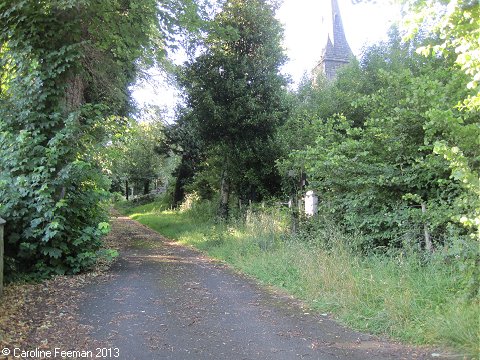 | 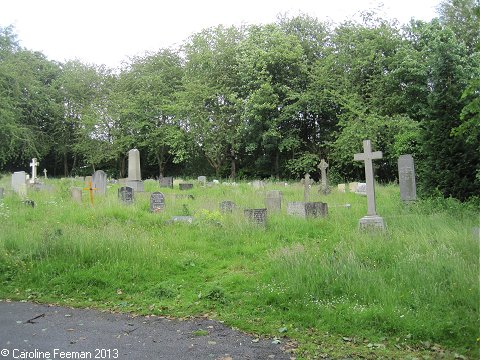 |
| The southern part of the churchyard (on the right hand side) | The northern part of the churchyard. |
St. John's is the final resting place of many of the 'great and good' of Leeds, not least many ancestors of The Duchess of Cambridge. The Luptons have several graves in the south section and a beautiful stained glass window representing the family inside the church. They played a large part in the development of the city and were active in city government and served on boards of the University and the Infirmary in the 19th and 20th centuries.
Two Mayors and five Lord Mayors of Leeds are buried in the south section, three of them being ancestors of the Duchess. These are Darnton Lupton, Charles Lupton and Hugh Lupton.
There are war graves in the south section from The First World War.
The crypt of the church holds the remains of the Nicholson family, the original benefactors.
My fear is that the City Mission will allow the church and the property to go to rack and ruin before 2015 when there will be little to no hope of saving this fine piece of Leeds history. I believe however that there is hope for the church if action is taken in the near future. Attention has been drawn to St. John's predicament in Leeds. A local group of committed citizens are working to keep the plight of St. John's in the public eye. Two excellent articles have been published in the Yorkshire Post, the Leeds Civic Trust are aware of St. John's predicament and have placed St. John's on their list of Buildings at Risk, the Friends of Roundhay Park published an article in their Newsletter in 2011 and the Oakwood and District Historical Society are aware of the state of affairs.
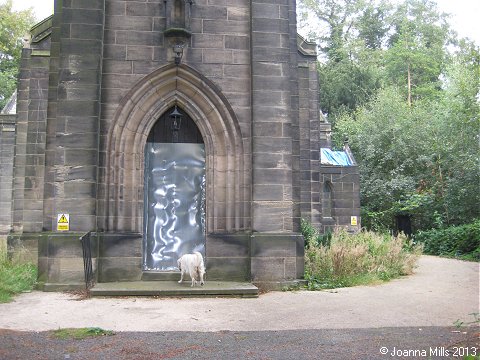 | 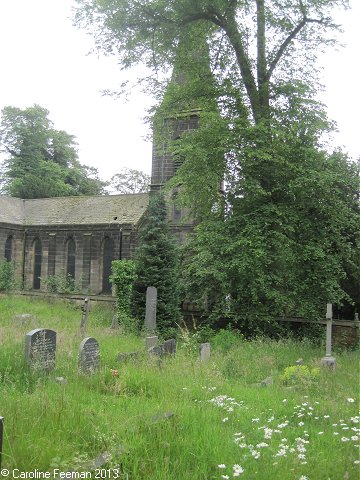 |
| The base of the tower | The state of the graveyard near the church. |
The south and older graveyard is closed to burials and in a bad state but graveyards are very much a part of local history and culture and are important sources of such.
I found the following in the preface of a book titled 'Relicts of Leeds' by Percy Robinson, 1896. True then and true now.
'This volume is placed before the public in the hope that it may serve as a record of some of those relics of Old leeds which, though they may not in all cases be of surpassing architectural merit, are yet interesting from their association with the post history of the town. Year by year we see these relics disappearing before the ever advancing tide of modern development.: The Mixed Cloth Hall and the Old Infirmary have recently disappeared, the former to make way for the new premises of the Yorkshire Penny Bank. Others are doomed and in a few years we shall have very little remaining of Old Leeds.
Caroline Feeman © 2013
Caroline supplied me with some information for the Genuki Church database and I asked her if she would care to write a bit more about the church and the current situation. The above article is the result. [Colin Hinson 2013]
©2013

